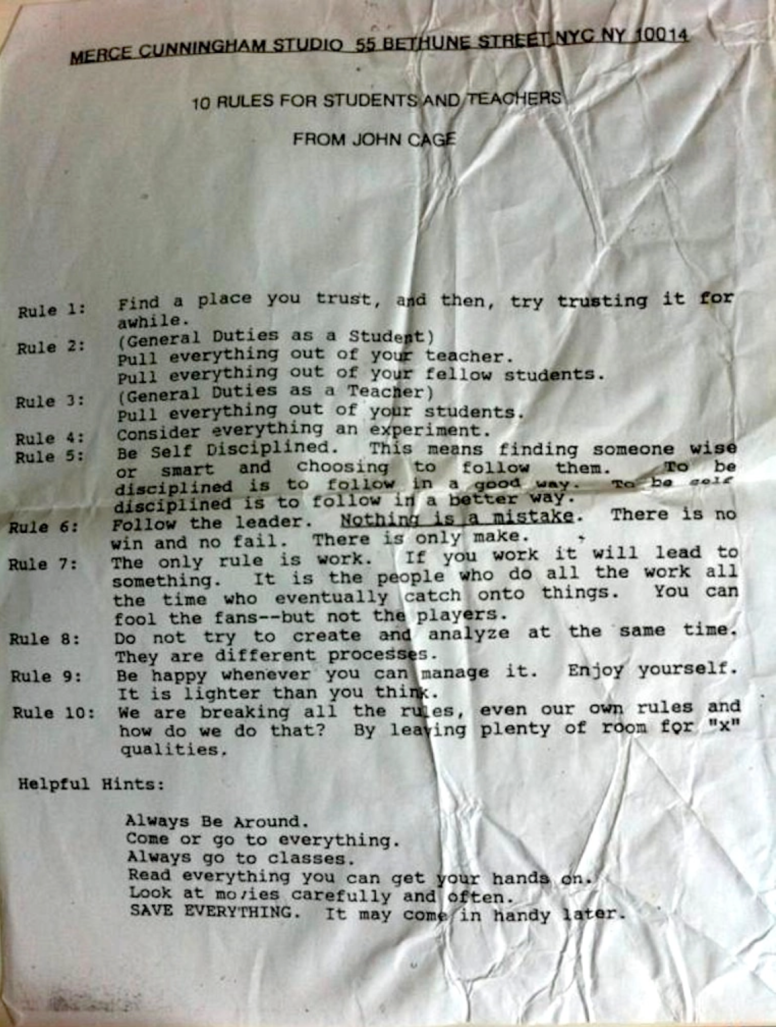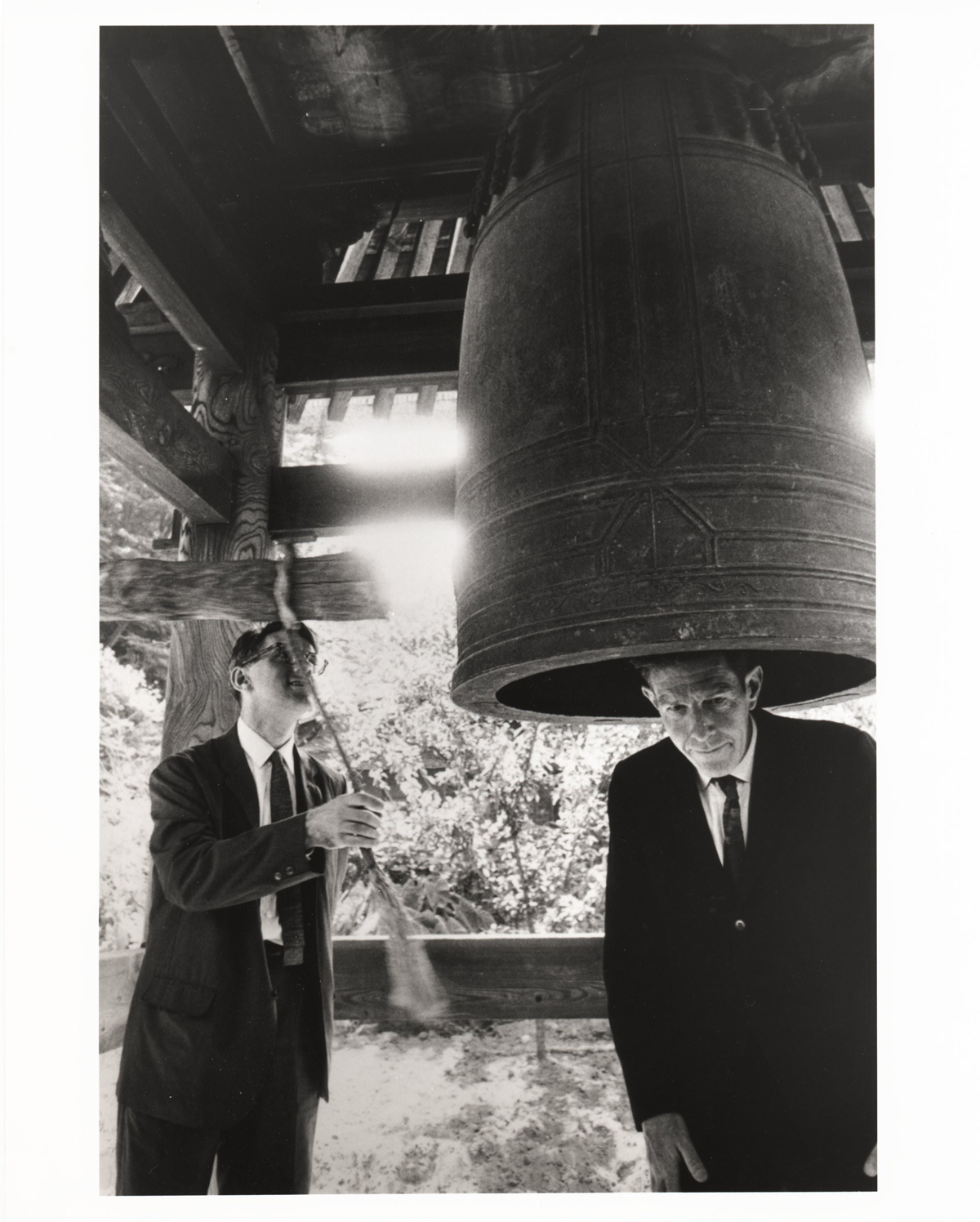
10 Rules for Students and Teachers by John Cage



Sometimes I check if the German site where John Cage’s Organ2 / ASLSP is being performed, expanded to an incredible 639 (six hundred and thirty-nine) years, still exists and the answer so far is yes.
To find out more about this epic execution that began in 2001 and destined to end in 2640, I refer
Finally, here you can hear the epic 2006 note change at 8:36 in this audio clip. The last was in 2013 and the next is expected on September 5, 2020.
This is the organ used for execution.
C’è anche questa versione di Matthew Reid che è abbastanza interessante. Reid ha eseguito il brano filtrando il microfono con un equalizzatore regolato in modo da rinforzare le frequenze di risonanza della stanza. Di conseguenza si è prodotto un feedback.
La registrazione è stata poi passata in Autotune che ha intonato tutti i feedback, sia il bordone del secondo movimento che i vari suoni del terzo. In un certo senso è una versione elettroacustica del brano.
La popolarità di John Cage ormai ha raggiunto livelli impensabili. Ecco 4’33” eseguito da Infestation, una brutal death metal band. I commenti su You Tube sono pochi, ma favorevoli e anch’io trovo sia un’esecuzione ben fatta.
Il 2012 è il centenario della nascita di John Cage e il ventennio dalla morte (Los Angeles, 5 settembre 1912 – New York, 12 agosto 1992). Ovviamente le celebrazioni sono molte. Presumibilmente, quasi tutta la sua opera sarà eseguita quest’anno e qualcuno si accorge anche di qualche problema.
Peter Urpeth, nel suo blog silentmoviemusic, ha fatto notare che, probabilmente, uno dei più famosi e caratteristici brani di Cage, Radio Music, composto nel 1956, diventerà ineseguibile a partire dal 2017 e forse la stessa fine farà Imaginary Landscape 4 (e qualche altro brano basato sulla radio). Questi pezzi, infatti, sono scritti per un certo numero di esecutori (da 1 a 8 il primo, 12 il secondo), ognuno munito di una radio. La partitura di Radio Music riporta una lista di frequenze su cui gli apparecchi devono essere sintonizzati nel corso del brano. La lista è indipendente dal luogo e dall’orario dell’esecuzione, per cui ne esce un insieme indeterminato di suoni. Occasionalmente, su qualche frequenza non c’è alcuna trasmissione e quindi si sente il silenzio della radio, fatto di rumore di statica con qualche disturbo casuale.
Il fatto che mette in pericolo Radio Music è lo spegnimento del segnale analogico previsto per il 2017, segnando il passaggio definitivo alle trasmissioni digitali. Le conseguenze sono due:
La partitura, dunque, appare obsoleta rispetto a un recente salto tecnologico. Non è la prima volta che questo accade nella storia della musica. Penso, per esempio, al passaggio dall’arco barocco a quello moderno, o dal clavicembalo al pianoforte, tuttavia, in questi casi, la sostanza del discorso musicale, cioè la successione di altezze, rimaneva e consentiva una nuova interpretazione.
Ci sono, poi, altri casi legati a un salto tecnologico. Nella musica elettronica il passaggio dall’analogico al digitale ha messo in crisi varie partiture. Tuttavia con il digitale si può emulare il 99% di quello che si faceva in analogico, sia pure con qualche differenza, ma che, in fondo, non è più grande di quella provocata dall’abbandono del clavicembalo in favore del pianoforte.
In questo caso, invece, è proprio la sostanza del brano a cambiare e se il suo significato, che consiste nella sovrapposizione casuale di varie sorgenti radiofoniche, può essere riprodotto, vengono a mancare sia una serie di rumori (statica, disturbi, ricerca della sintonia), che quella commistione di trasmissioni normali e di servizio (sistemi di trasporto, emergenze, CB) che un tempo lavoravano con lo stesso medium, ma che ora sono definitivamente separati.
Non credo, comunque, che Cage si sarebbe preoccupato più di tanto della fine di Radio Music, anzi l’avrebbe accolta come un altro passo verso il silenzio, ma il silenzio digitale è troppo perfetto…
Nell’immagine David Tudor e John Cage (click per ingrandire), trovata via johncage.org.
John Cage – In The Name of the Holocaust (1942), for prepared piano.
Like much of Cage’s early dance music (this to accompany a piece by Merce Cunningham), In the Name of the Holocaust was written for what Cage would later refer to as a ‘prepared piano’: a piano with screws, bolts, or other materials placed between certain strings to create a percussive effect.
The music features a number of new piano techniques, many of which Cage borrowed from his teacher Henry Cowell: notes held open for resonance, muted and plucked strings, and clusters played with the arm and flat of the hand. The title references World War II and comes from a pun on the Catholic liturgical phrase “In the Name of the Holy Ghost” found in James Joyce’s novel Finnegans Wake.
Listen to
Robert Wyatt sings John Cage’s The Wonderful Widow of Eighteen Springs for voice and piano. The piano stay closed and is used as a percussion instrument.
The song was commissioned by singer Janet Fairbank, who later became known for pioneering contemporary music. Cage chose to set a passage from page 556 of Finnegans Wake, a book he bought soon after its publication in 1939. The composition is based, according to Cage himself, on the impressions received from the passage. The Wonderful Widow of Eighteen Springs marks the start of Cage’s interest in Joyce and is the first piece among many in which he uses the writer’s work.
The vocal line only uses three pitches, while the piano remains closed and the pianist produces sounds by hitting the lid or other parts of the instrument in a variety of ways (with his fingers, with his knuckles, etc.) Almost immediately after its composition the song became one of Cage’s most frequently performed works, and was several times performed by the celebrated duo of Cathy Berberian and Luciano Berio. Cage later composed another piece for voice and closed piano, A Flower, and a companion piece to The Wonderful Widow of Eighteen Springs, called Nowth upon Nacht, also based on Joyce’s book.
From Obscure 1 LP
John Cage, Freeman Études for solo violin (1977). A piece whose form is due to a set of misunderstanding.
In 1977 Cage was approached by Betty Freeman, who asked him to compose a set of etudes for violinist Paul Zukofsky (who would, at around the same time, also help Cage with work on the violin transcription of Cheap Imitation). Cage decided to model the work on his earlier set of etudes for piano, Études Australes. That work was a set of 32 etudes, 4 books of 8 études each, and composed using controlled chance by means of star charts and, as was usual for Cage, the I Ching. Zukofsky asked Cage for music that would be notated in a conventional manner, which he assumed Cage was returning to in Études Australes, and as precise as possible. Cage understood the request literally and proceeded to create compositions which would have so many details that it would be almost impossible to perform them.
In 1980 Cage abandoned the cycle, partly because Zukofsky attested that the pieces were unplayable. The first seventeen études were completed, though, and Books I and II (Études 1-16) were published and performed (the first performance of Books I and II was done by János Négyesy in 1984 in Turin, Italy). Violinist Irvine Arditti expressed an interest in the work and, by summer 1988, was able to perform it at an even faster tempo than indicated in the score, thus proving that the music was, in fact playable. Arditti continued to practice the études, aiming at an even faster speed, apparently misreading Cage’s indication in the score to play every measure in “as short a time-length as his virtuosity permits”, in which Cage simply meant that the duration is different for each performer. Inspired by the fact that the music was playable, Cage decided to complete the cycle, which he finally did in 1990 with the help of James Pritchett, who assisted the composer in reconstructing the method used to compose the works (which was required, because Cage himself forgot the details after 10 years of not working on the piece). The first complete performance of all Études (1-32) was given by Irvine Arditti in Zurich in June 1991. Négyesy also performed the last two books of the Etudes in the same year in Ferrara, Italy. [wikipedia]
Un video in cui David Tudor itself esegue 4’33”, registrato molto probabilmente per una TV giapponese.
Interessante il messaggio che scorre in sovrimpressione:
You are invited to turn down the volume of your TV set, and listen to the ambient sounds present wherever this program is performed.
Notations, la leggendaria antologia edita nel 1969 da John Cage ed Alison Knowles, contenente molti esempi di notazione grafica e ormai da anni fuori catalogo, è disponibile per il download qui. (att.ne pdf di 300+ pagine, circa 74 Mb)